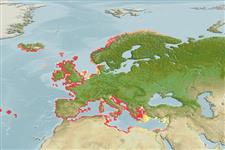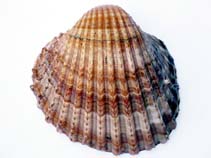Acanthocardia aculeata (Linnaeus, 1758)
Spiny cockle| Native range | All suitable habitat | Point map | Year 2050 |

|
| This map was computer-generated and has not yet been reviewed. |
| Acanthocardia aculeata AquaMaps Data sources: GBIF OBIS |
Все изображения | Изображение на Google | Stamps, coins, misc.Acanthocardia aculeata
Классификация / Names народные названия | синонимы | CoL | ITIS | WoRMS
Bivalvia | Cardiida | Cardiidae
Environment: milieu / climate zone / пределы глубины / distribution range экология
; пределы глубины 5 - 30 m (ссылка 2758). Temperate; 54°N - 30°N, 11°W - 36°E
Distribution страны | регионы FAO | Ecosystems | места находок | интродукции
Northeast Atlantic and the Mediterranean: from Celtic and Lusitanian provinces, extending into the Mediterranean.
Length at first maturity / Size / Weight / Возраст
половая зрелость: Lm ? range ? - ? cm Max length : 10.2 cm SHL самец/пол неопределен; (ссылка 360); common length : 7.6 cm SHL самец/пол неопределен; (ссылка 360)
Краткое описание морфология
Life cycle and mating behavior половая зрелость | размножение | нерест | Eggs | Fecundity | Larvae
Основная ссылка
ссылки | координатор | соавторы
Gaspar, M.B., M.N. Santos and P. Vasconcelos 2001 Weight-length relationships of 25 bivalve species (Mollusca: Bivalvia) from the Algarve coast (southern Portugal). J. Mar. Biol. Ass. U.K. 81:805-807. (ссылка 2758)
Статус Красного Списка МСОП
(ссылка 130435: Version 2025-1)
Статус СИТЕС (ссылка 108899)
CMS (ссылка 116361)
Угроза для людей
Использование человеком
рыболовство: коммерческий
| FishSource |
инструменты
дополнительная информация
состав пищи
потребление пищи
хищники
ресурсы в Интернет
BHL | BOLD Systems | CISTI | DiscoverLife | FAO(Publication : search) | Fishipedia | GenBank (Геном, Нуклеотид) | GloBI | Gomexsi | Google Books | Google Scholar | Google | PubMed | Tree of Life | Wikipedia (Вперёд, поиск) | Zoological Record



